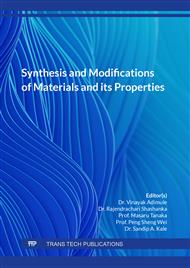p.35
p.47
p.59
p.71
p.85
p.91
p.101
p.107
p.113
Effect of Process Parameters on Properties of Titanium Alloy during Thermal Simulation Deformation
Abstract:
In this paper, aiming at the heat resistance and thermal deformation process of titanium matrix composites 0 vol.%, 2.5.vol.%, 5.vol.%. Thermal simulation experiment of titanium matrix composites with different (TiB+TiC) strengthening phase content. The measurement accuracy of material displacement is 0.01 mm. The compression is 70%, and the strain rate is 0.1 mm/s and 0.01 mm/s respectively. Compression tests at different strain rates and temperatures were carried out. The experimental results show that when the (TiB+TiC) 5vol% titanium composite is deformed at 0.01mm/s low strain rate, the peak stresses corresponding to 25°C, 250°C,350 °C and 500°C are increased to 1096MPa, 835MPa, 646MPa and 416MPa respectively. Under the condition of high strain rate of 0.1mm/s, the peak stresses corresponding to 25 °C, 250 °C, 350 °C and 500 °C are increased to 1230 MPa, 896 MPa, 723 MPa and 471 MPa respectively. The deformation law of stress rheological curve is roughly the same, and the high temperature zone has good plastic deformation ability. The titanium matrix composite has high compression rheological mechanical properties and good high-temperature plastic deformation ability. It is the preferred material component for the preparation of titanium matrix composite and powder forging.
Info:
Periodical:
Pages:
101-106
Citation:
Online since:
August 2022
Authors:
Price:
Сopyright:
© 2022 Trans Tech Publications Ltd. All Rights Reserved
Share:
Citation:



